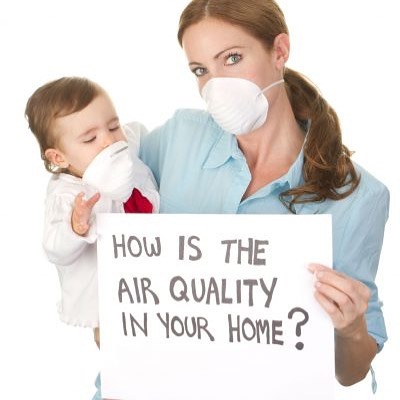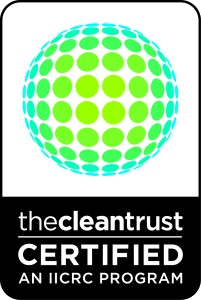The air inside can harm your family’s health more than the outdoors.
Is the air in your home safe to breathe?
It is not always easy to tell if your home has poor air quality. You may notice bad smells or smoke, but you cannot see or smell other dangers, like carbon monoxide or radon. This chapter and those on asthma and allergies, mold, and carbon monoxide will help you ask the right questions to determine if your home’s air is healthy and safe. They will also give you ideas about how to fix any problems you might find.
Asthma and Allergies
If someone in your home has health problems or is ill, polluted indoor air can make them feel worse. For example, asthma is a lung disease that affects a growing number of children. Indoor air pollution can make
it worse. Insects and other pests can also be a real problem for people with asthma or allergies. For example, cockroaches and dust mite droppings cause asthma attacks in some people. Pesticides can help fight these pests, but they can be dangerous. Use bug spray and other pesticides safely. See page 11 to learn about making your home healthier for people with asthma or allergies.
Mold
Mold grows in damp places. It often smells musty. Many people are allergic to mold. Some kinds of mold are toxic, and coming into contact with large amounts of mold may cause health problems. Talk to a doctor if you think mold is causing health problems for you or your family. See the post on Mold and Moisture to learn more about controlling mold in your home.
Carbon Monoxide
Carbon monoxide is a deadly gas that can come from appliances that burn gas, oil, coal, or wood and are not working as they should. Car exhaust also has carbon monoxide. You cannot see, taste, or smell carbon monoxide. See page 23 for more information on how to protect your family from carbon monoxide poisoning.
Radon Gas
Radon is another gas. It can get into some homes from the ground below them. You cannot see, taste, or smell radon. Radon is found all over the United States. Radon can cause lung cancer. It is the second leading cause of lung cancer in the U.S. If you smoke and your home has high levels of radon, your risk of lung cancer is especially high.
• Have you ever tested your home for radon?
• Do any of your neighbors have problems with radon gas? If so, you might also have a radon problem. Living in a Healthy Hom
Indoor Residential Air Pollutants
• Tobacco smoking causes cancer and other major health problems. It’s unsafe for children to be around smokers. Second-hand or environmental tobacco smoke can raise children’s risk of ear infections and breathing problems. It can trigger asthma attacks, too.
• Many families have pets. However, furry pets cause problems for some people. Pets can make asthma and allergies act up, especially if you keep them in sleeping areas.
• Hobbies and home projects sometimes involve sanding, painting, welding, or using solvent chemicals, like varnish or paint strippers. (A solvent is a chemical that can dissolve something else. Solvents are usually liquid.) Home projects can pollute the air with dust or harmful chemicals. Sometimes, indoor air pollution comes from what people have in their homes.
• Some household products, especially those with solvents, can pollute the air if you don’t use them correctly. See Hazardous Household Products for more information about household products
• New furniture, carpets, and building products may give off chemicals used in their making. Some of these chemicals can harm people, especially children.
• If your home was built before 1978, the paint may have lead. Lead is very dangerous for young children. See Lead Concerns to learn about protecting your children from lead poisoning.
Sometimes, indoor air pollution comes from what people have in their homes.
• Some household products, especially those with solvents, can pollute the air if you don’t use them correctly. See Household Products for more information about household products
• New furniture, carpets, and building products may give off chemicals used in their making, such as Formaldehyde (HCHO). Some of these chemicals can harm people, especially children.
• If your home was built before 1978, the paint may have lead. Lead is very dangerous for young children. See Lead Concerns to learn about protecting your children from lead poisoning
Your Family’s Health
• Does anyone in your family have asthma or allergies?
• Does a family member notice burning eyes, coughing, or sneezing that happens most often while at home?
• Does anyone in your home have chronic bronchitis or another lung disease?
Living in a Healthy Home
• Do some areas in your home smell damp or musty?
• Have you seen cockroaches in your home?
• Do you know how to run and care for your fuel-burning appliances safely?
• Do you allow smoking in your home?
• Do you have furry pets in your home? In the bedrooms?
• Do you read the labels on household products and follow the directions for using them safely?
• Do you open windows or turn on fans during hobbies or projects that make dust or odors?
• Do you try to do dusty or smelly projects outdoors?
• Do you choose furniture, carpet, and building products made with non-toxic chemicals and materials? These are sometimes called green building products.
• Does your home smell musty, damp, smoky, or like chemicals?
• Does your home seem stuffy or stale? Can you smell cooking odors the next day?
• Do your bathroom and kitchen have exhaust fans—do you use them?











